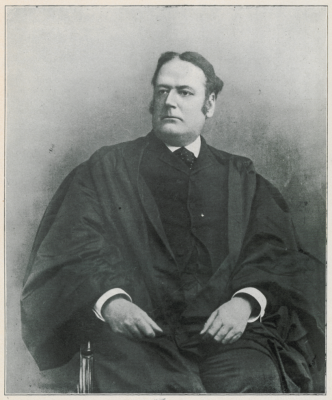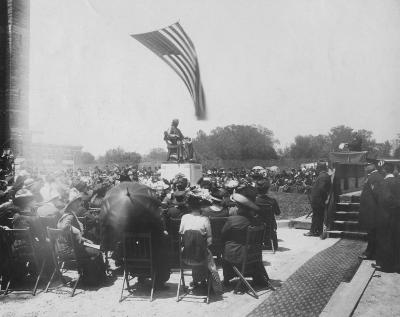Edward Douglass White, Jr. (November 3, 1845 – May 19, 1921) was an alumnus of Georgetown College, a lawyer, politician, and judge. In some alumni publications he is listed as having graduated from the College in 1858, although an 1894 article in the Georgetown College Journal said that he "came to Georgetown in 1857 and remained until 1861, when he returned home [to Louisiana] and entered the Confederate army."1 In 1905 he was elected president of the Alumni Association.2
White began practicing law in Louisiana in 1868, was elected a state senator in 1874, was appointed as an Associate Justice of the Louisiana Supreme Court in 1878, and was elected as United States Senator from Louisiana in 1891. He resigned that position in 1894 when President Grover Cleveland appointed him as associate justice of the United States Supreme Court.3 This appointment came after two of Cleveland's previous nominees were defeated by the U.S. Senate.4 In 1910, President William Howard Taft appointed him as Chief Justice, a position he held until his death in 1921.5
In May 1912, White presented the statue of Georgetown founder John Carroll, S.J. on behalf of alumni.6 At that time he was considered "the most distinguished of Georgetown's Alumni"7 and Senator-elect Joseph E. Ransdell of Louisiana called White "the greatest conservative factor in the republic."8
One of White's major impacts on American constitutional law came from his 1911 opinion on anti-trust cases related to Standard Oil and American Tobacco. Constitutional historians Alfred H. Kelly and Winifred A. Harbison wrote that White's decision in these cases "made it virtually impossible to prosecute any great trust successfully, for almost any monopoly could put up a plausible argument for social responsibility and thus claim to be a reasonable combination."9
In 1904, students at the School of Law formed the Edward Douglass White Law Club.10
White received the honorary LL. D. degree from Georgetown University in 1892. He received the same honorary degree from Princeton University in 1912, and also held an LL. D. from St. Louis University.11
White's childhood home in Thibodaux, Louisiana is listed on the United States Register of Historic Places. During his time in Washington, he lived at 1717 Rhode Island Ave. NW.12
- 1"Hon. Edward D. White," Georgetown College Journal, March 1894, p. 103. http://hdl.handle.net/10822/1044468
- 2"With the Old Boys," Georgetown College Journal, July 1905, Vol. XXXIII No. 10, p. 484. http://hdl.handle.net/10822/1049805
- 3"Hon. Edward D. White," Georgetown College Journal, March 1894, p. 103. http://hdl.handle.net/10822/1044468
- 4"National Register of Historic Places Nomination Form," https://npgallery.nps.gov/NRHP/GetAsset/NHLS/76000964_text
- 5"Justices, 1789 to Present," https://www.supremecourt.gov/about/members_text.aspx
- 6"Carroll Monument Celebration," Georgetown College Journal, May 1912, Vol. XL No.8, p. 268. http://hdl.handle.net/10822/1049861
- 7"Carroll Monument Celebration," Georgetown College Journal, May 1912, Vol. XL No.8, p. 269. http://hdl.handle.net/10822/1049861
- 8"The Alumni Banquet," Georgetown College Journal, May 1912, Vol. XL No.8, p. 302. http://hdl.handle.net/10822/1049861
- 9"National Register of Historic Places Nomination Form," p. 501. https://npgallery.nps.gov/NRHP/GetAsset/NHLS/76000964_text
- 10John O'Day, Jr., "Law School Notes," Georgetown College Journal, November 1916, Vol. XLV No. 2. p.84. http://hdl.handle.net/10822/1049900
- 11"Chief Justice White Honored," Georgetown College Journal, May 1912, Vol. XL No.8, p. 315. http://hdl.handle.net/10822/1049861
- 12"National Register of Historic Places Nomination Form," p. 502. https://npgallery.nps.gov/NRHP/GetAsset/NHLS/76000964_text



